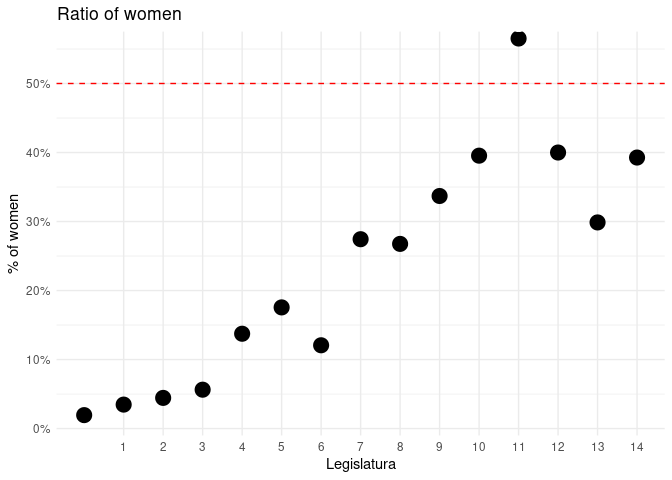The goal of senadoRES is to provide information about the Senate of Spain. It uses the Open Data available and some other XML files I found while exploring the website.
Installation
You can install the released version of senadoRES with:
remotes::install_github("llrs/senadoRES")Example
To make it easier to work and show some data I’ll use some packages:
library("senadoRES")
library("dplyr")
#>
#> Attaching package: 'dplyr'
#> The following objects are masked from 'package:stats':
#>
#> filter, lag
#> The following objects are masked from 'package:base':
#>
#> intersect, setdiff, setequal, union
library("ggplot2")Senadores
This function return the members of the Senate:
ts <- senadores()
head(ts)
#> nombre apellidos legislatura ultCredencial procedTipo
#> 1 FERNANDO ABAD BÉCQUER 5 260 D
#> 2 ENRIQUE ABAD BENEDICTO 10 034 E
#> 3 ELISABET ABAD GIRALT 12 051 D
#> 4 JOSÉ ANTONIO ABAD LÓPEZ-BREA 3 039 E
#> 5 PATRICIA ABASCAL JIMÉNEZ 14 199 E
#> 6 ADOLFO ABEJÓN ORTEGA 9 081 E
#> procedLiteral procedLugar grupoCod grupoSiglas
#> 1 Designado Asamblea de Madrid Asamblea de Madrid 800
#> 2 Electo Sevilla Sevilla 800
#> 3 Designada Parlamento de Cataluña Parlamento de Cataluña 807
#> 4 Electo Zamora Zamora CP
#> 5 Electa Eivissa-Formentera Eivissa-Formentera 800
#> 6 Electo Valladolid Valladolid 801
#> grupoNombre sex
#> 1 GPS male
#> 2 GPS male
#> 3 GPN female
#> 4 GPCP male
#> 5 GPS female
#> 6 GPP maleWe can see the increase of females on the Senate along the legislatures:
ts %>%
group_by(legislatura) %>%
count(sex) %>%
mutate(total = sum(n)) %>%
filter(!is.na(sex)) %>%
mutate(ratio = n/total) %>%
filter(sex != "male") %>%
ggplot() +
geom_point(aes(legislatura, ratio), size = 5) +
geom_hline(yintercept = 0.5, linetype = 2, col = "red") +
scale_x_continuous(breaks = seq_len(15)) +
scale_y_continuous(labels = scales::percent_format(accuracy = 1),
breaks = seq(from = 0, to = 1, by = .1),
expand = expansion(add = c(0.01, 0.01)), limits = c(0, NA)) +
theme_minimal() +
labs(title = "Ratio of women", x = "Legislatura", y = "% of women") +
guides(col = FALSE, shape = FALSE) +
theme(panel.grid.minor.x = element_blank())
Or see what has been done:
b <- boletin(boletin_csv(14, 1))
b[, c("FECHA", "DISP", "apartado", "subapartado", "TITULO", "document")]
#> FECHA DISP apartado subapartado
#> 1 2019-12-05 1 VI. Administración del Senado Personal eventual
#> 2 2019-12-05 2 VI. Administración del Senado Personal eventual
#> 3 2019-12-05 3 VI. Administración del Senado Personal eventual
#> TITULO
#> 1 Personal eventual del Senado como Asistentes de los señores Senadores de los Grupos Parlamentarios de la XIII Legislatura.
#> 2 Personal eventual adscrito a la Presidencia, Vicepresidencias Primera y Segunda y Secretarías Primera y Cuarta del Senado de la XIII Legislatura.
#> 3 Personal eventual al servicio del ex-Presidente del Senado.
#> document
#> 1 BOCG_D_14_1_1
#> 2 BOCG_D_14_1_2
#> 3 BOCG_D_14_1_3So, on the first session of the 14th legislature they dealt with human resources. We can check one of those documents, to retrieve the text with documento.
Site built with pkgdown 1.6.1.
Template by Bootstrapious . Ported to pkgdown by dieghernan.
 senadoRES
senadoRES